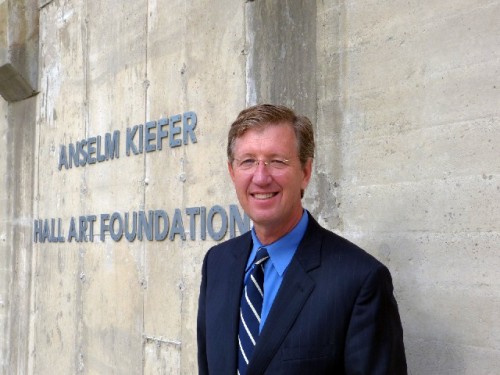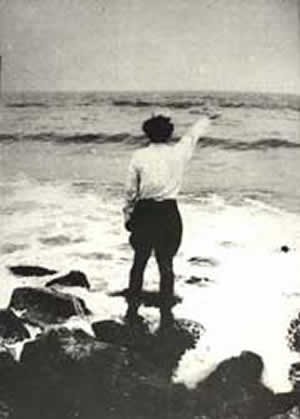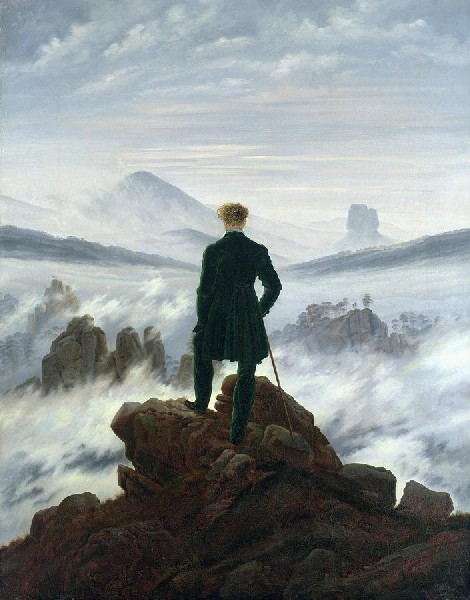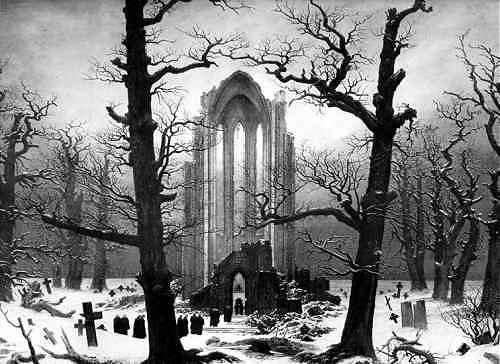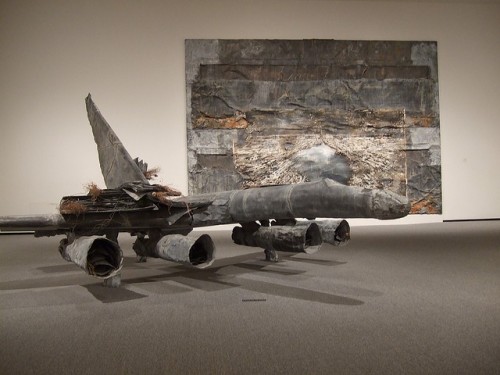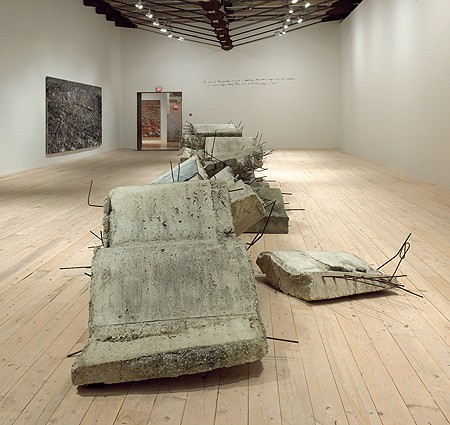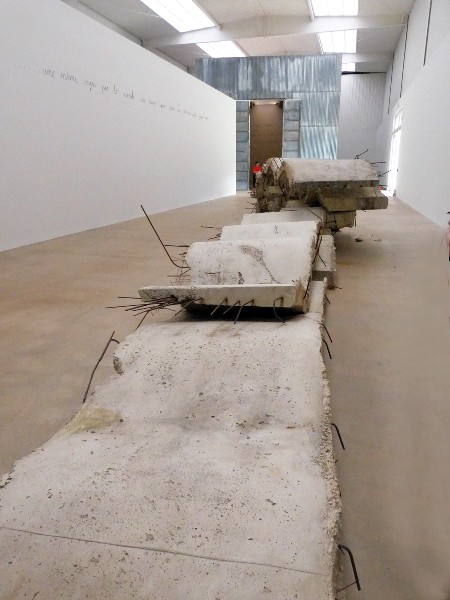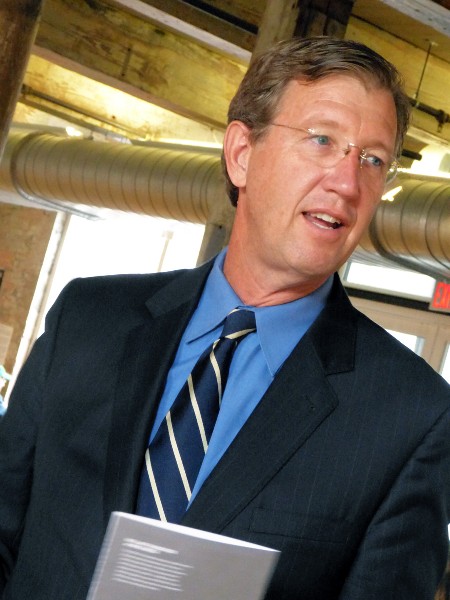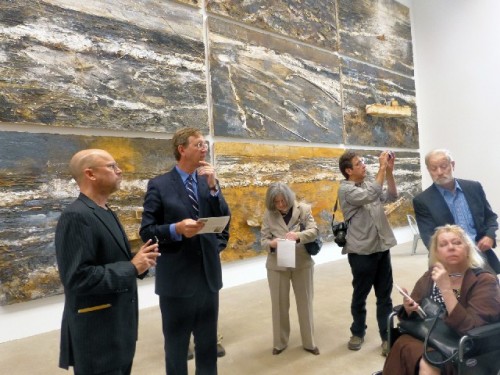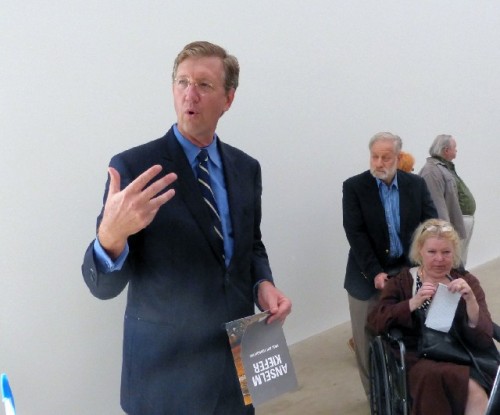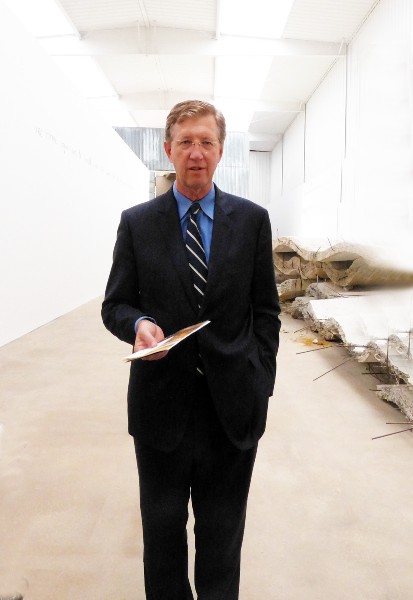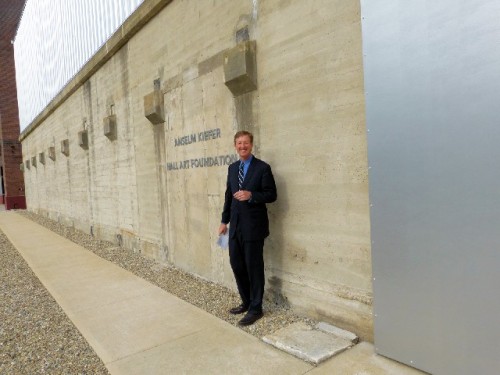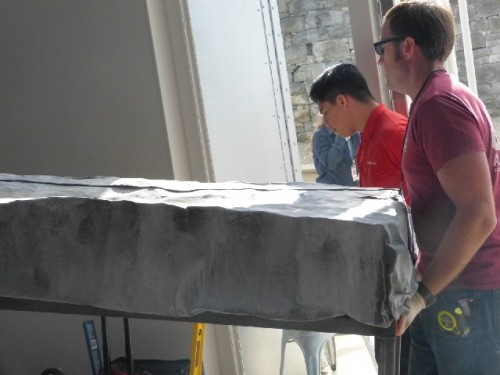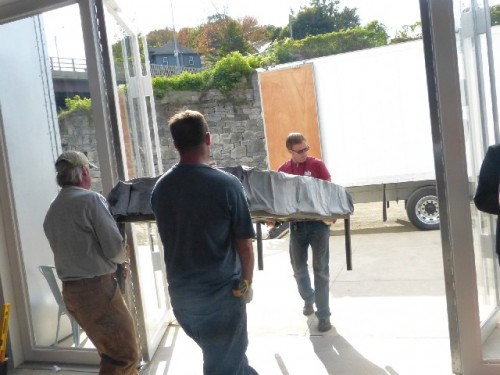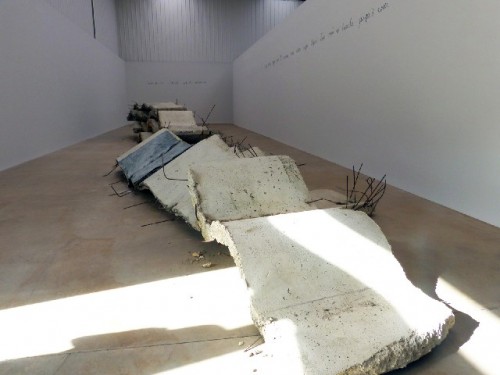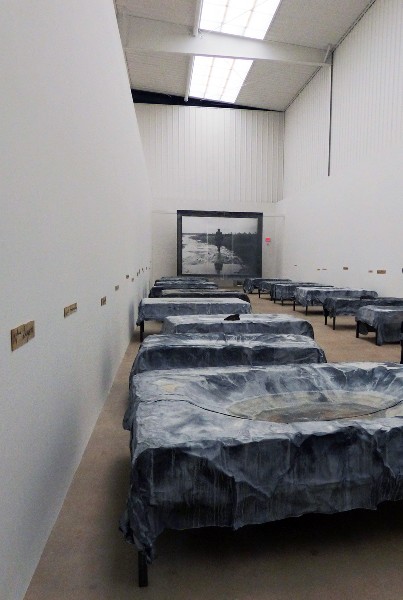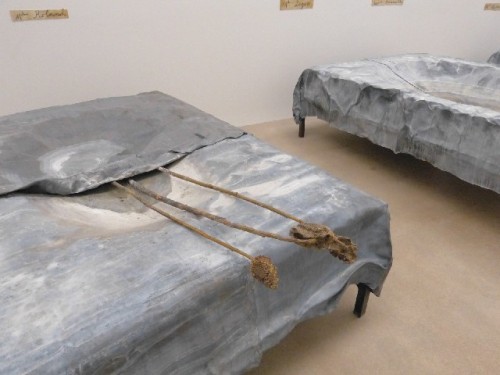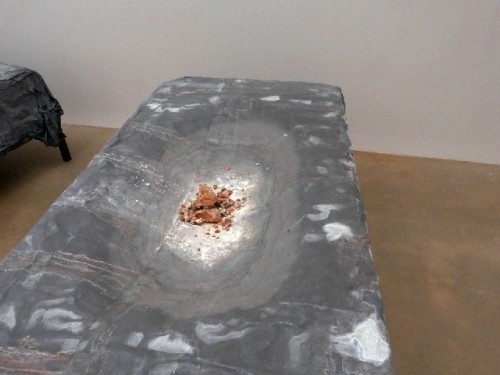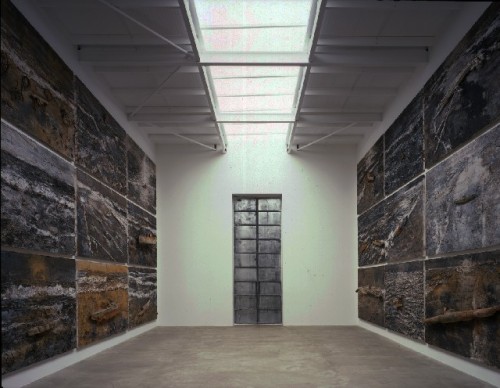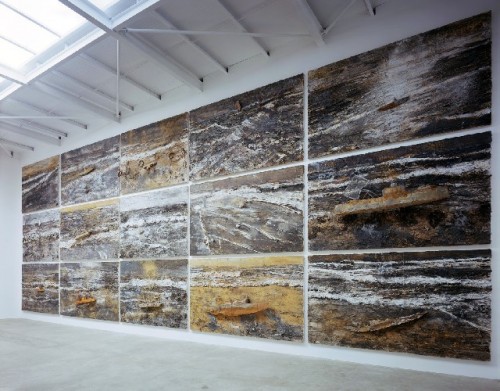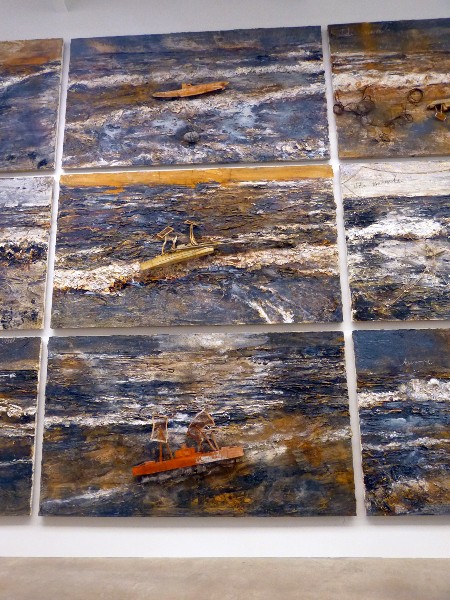Anselm Kiefer at Mass MoCA for 15 Years
Building Developed with Hall Art Foundation
By: Charles Giuliano - Sep 27, 2013
Using thick paint, mud, straw, clay, lead, concrete, his own semen and industrial detritus the paintings, sculptures and books of the German artist Anselm Kiefer (born 1945) are intended to morph and disintegrate over time. It is a compelling image of the decay of materials used in art as a metaphor for the decline and fall of civilizations.
The artist was born precisely when the 1000 Year Reich envisioned by Adolph Hitler ended in the defeat and division of Germany. That grim heritage and legacy of a generation growing up after the war informed his art and its theme of Götterdämmerung.
Responding to the Holocaust, and infamy of a Nazi past, was a catalyst that inspired a remarkable generation of Post War filmmakers, writers and artists. A transitional figure in the fine arts was Joseph Beuys who flew missions for the Luftwaffe before he was shot down in the Crimea. To save him from hypothermia the rescuers smeared him with fat and rolled him in an envelope of felt.
These became materials in his work. Beuys created actions or social sculptures and was an openly accessible professor of art. His unique approach and vision influenced the young Kiefer and one may still follow that thread in the work.
Among Kiefer’s earliest works were photographs of the artist dressed in paramilitary costumes at sites associated with the war with his arm raised in a Heil Hitler salute. Many of the early paintings and monumentally scaled, assembled woodcuts depicted the neo classical fascist architecture of Albert Speer in ruins. There were depictions of dense forests with portraits of historic Germanic artists, musicians, philosophers and scientists.
There were controversial responses to motivations and political sentiments of the artist regarding the Nazi past. While unique and compelling there was also a connection to the Northern European, romantic tradition of neo Gothic mythology, metaphors of nature, and iconography.
Compare, for example, Kiefer’s Nazi salute photographs set in nature to the solitary figure in the iconic Caspar David Friedrich (1774 – 1840) painting Wanderer above the Sea of Fog 1818 from Kunsthalle, Hamburg. There was a 19th century fascination with Ruins from literature and poetry to the fine arts. Landscape architects created ruins and follies in their gardens. Theorists discuss this as an aspect of the sublime.
It is entirely consistent to view the work of Kiefer, particularly his landscapes and deliberate ruins, or decaying works, within the Northern European romantic tradition of Friedrich. While the metaphor maybe be similar the context is contemporary and thereby different. We may reach further back to the memento mori Dutch still life paintings and their origin in Roman mosaics.
Consider Hamlet’s speech “Let me see. (he takes the skull) Oh, poor Yorick! I used to know him, Horatio—a very funny guy, and with an excellent imagination. He carried me on his back a thousand times, and now—how terrible—this is him. It makes my stomach turn. I don’t know how many times I kissed the lips that used to be right here. Where are your jokes now? Your pranks? Your songs? Your flashes of wit that used to set the whole table laughing? You don’t make anybody smile now. Are you sad about that? You need to go to my lady’s room and tell her that no matter how much makeup she slathers on, she’ll end up just like you some day. That’ll make her laugh.”
On the vast grounds of his studios outside Paris Kiefer often leaves works in progress outside to be aged and distressed by the elements. For a long time he crafted “toys” including airplanes and boats, submarines out of lead. These and other elements may lie around for years before they are incorporated into works. His works often are in progress over long intervals in varying states.
When they are sold to collectors or museums the artist has stated that they “die.” It is the responsibility of the owners to intervene or not in their metamorphosis. Which is philosophically and aesthetically daunting considering that obsolescence is mandated into the work. Generations from now the work is likely to look quite different. This is, of course, a factor in all art.
What would we think and feel, for example, had we the opportunity to see the original Parthenon sculptures of Phidias and his workshop in a pristine state mounted on the temple? Based on the Elgin Marbles in the British Museum the broken fragment is the norm for classical Greek art.
Yesterday three monumental works by Kiefer- “Etroits sont les viasseaux” “Velimir Chlebnikov” and “Les Femmes de la revolution” loaned and funded by Hall Art Foundation opened in a newly developed 10,000 square foot, former water cistern. They will remain on view at Mass MoCA for the next fifteen years.
The reclusive artist, who rarely grants interviews, has been deeply involved in the design and placement of the long term installation. Preparators were working round the clock for the weekend long opening and VIP receptions. They were making final adjustments when Joe Thompson, the director of the museum, started a tour in the main lobby of Mass MoCA.
As we spoke Kiefer and his entourage were spotted passing through and exiting the lobby. We caught a glimpse of the artist in a long coat and cap.
Keeping the media distracted Thompson said “"I think this opening signals the next five to 10 years of development here at Mass MoCA. Over the first 12 years we've been open, we created our own shows with this rollicking schedule of always-changing exhibitions, always temporary, side-by-side with performances and music festivals. We had a particular focus on work from mid-career and emerging artists -- that was the heart and soul of what we did."
He provided a capsule of the museum and its unique mandate. It is ironic that Mass MoCA does not have “one cent” for the acquisition of works, but through unique relations with first Yale University Art Museum, and now the Hall Art Foundation, it is able to show works that are beyond the means of any museum to buy. Compared to wealthy collectors like the Halls, who own some 5,000 works, and collect in depth artists they particularly covet, museums act slowly and methodically.
It is interesting that these long term installations- LeWitt for 25 years and Kiefer for 15- come close to the original vision of museum founder Tom Krens. As he told me for Art News, not long after the plan was announced, the vast industrial spaces would be used, with low maintenance and minimal utilities, to show private and museum collections which are, for the most part, in storage. Very close to the concept of Krens most of the Kiefer building, other than the self contained inner structure with paintings, will not be heated and open from April through late November.
"It's a strange thing. It's a beautiful thing," Thompson said. "I doubt the Metropolitan or the Museum of Modern Art would ever invite an entire third party in and give them space for a significant amount of time to do new programmatic work and essentially put forth a curatorial vision that's not always theirs."
He stated that "I want to point out that structurally, in building this museum and looking toward the future, I like a series of milestone installations -- that go deep and go very long -- side-by-side with our free-wheeling program of changing exhibitions. We're delighted the Hall Art Foundation and Andy and Christine Hall have joined up with us to help shape this fundamentally new model of museum building, based on the sharing of museum infrastructure, such as ticket taking, docents and security. We're creating a real economy by coming together on common ground and bringing public the work on the scale we do here at Mass MoCA"
No financial details were offered to the press but the entire project from creating a new structure above the foundation, the development of a bypass road and infrastructure, the purchase and loan of the works and their maintenance were entirely funded by Hall Art Foundation.
In a thumbnail Thompson described how in the past decade there has been an accumulation of wealth by the top one percent that is comparable to the fortunes of the 1920s. He described a cycle in which, about a generation later, those great collections found their way to museums. In some cases collectors on that level create their own museums or add wings to existing ones.
Often the individuals who amass great wealth do so by ruthless means. The creation of foundations, charities and bequests to arts organizations and museums by their heirs may be viewed as driven by atonement and guilt. It is a means of coping with the embarrassment of riches.
This was the drift of coverage of the new Kiefer building at Mass MoCA by Sebastian Smee in the Boston Globe. “(this is)… a story that stirs into the same simmering pot the attempted rehabilitation of a great German artist, of a whole town, and of a British oil trader referred to by his peers in finance as ‘God.’ The resulting potion, spiced up with eye of newt and powdered unicorn horn, promises to have a real kick. But will it taste funny?
“The German artist is Kiefer, an artist in his late 60s hoping to entrench his once-faltering legacy. The town is North Adams, a once thriving factory town that fell into an economic quagmire and has lately sought redemption through art.
“The oil trader is Andrew Hall, a financial whiz who was cast as a villain for commanding a $100 million bonus while working for Citigroup in 2008 — the same year that company took a $45 billion government bailout. Hall now owns 2,400 acres in Reading, Vt., where he raises heritage breed pigs, chicken, and cattle, and shows, by appointment, selections from his 5,000-work collection of contemporary art in a renovated dairy barn.”
Starting with the Nazi inflected early works Kiefer has been no stranger to controversy. The Globe implies that the Mass MoCA project may be an aspect of rehabilitating the artist’s reputation. “Kiefer’s reputation crashed in the 1990s, and especially after 1993, when, after leaving his wife and children, he exhibited hundreds of handmade books purposefully stained with his own semen. Twenty years’ worth of the stuff.”
The Halls have a particular passion for contemporary German art (Georg Baselitz, Joseph Beuys, Jörg Immendorff, A. R. Penck, the Austrian Franz West as well as Richard Artschwager, Andy Warhol and Malcolm Morley.) From Baselitz (born 1938) they purchased a property with studio and its contents. It was by this means that they acquired the artist’s large collection of early Kiefer artist’s books and photographs. A selection of this material is on view currently at the Williams College Museum of Art.
Some years ago Kiefer visited Mass MoCA as did Andrew and Christine Hall. During a tour of their Connecticut home Thompson was impressed by the sprawling concrete Kiefer sculpture on their lawn. The neighbors considered it an eyesore in their upscale neighborhood and sued to have it removed. Thompson stated that he would be glad to show it at Mass MoCA while they were trying to find a suitable place to display or store it.
That led to an 18 month installation of “Etroits sont les viasseaux” an 82-foot-long wave-like structure of concrete and rebar. The Halls also loaned several of their large Kiefer paintings. In the next gallery is the ongoing display of a major work by Beuys.
At the end of that extended exhibition the work was returned to the collectors but initiated discussions of a longer term display. They were impressed by what had been done with Yale’s collection of works by LeWitt.
As I have discussed with Thompson, Mass MoCA is running out of vacant buildings to develop. The search with the Halls for a suitable building had reached a dead end. While touring the campus the question arose about the abandoned water cistern. It was located next to the three story, wooden, Building 15 which, too expensive to renovate, was razed.
The building which was constructed over the abandoned foundation is unlike any other at Mass MoCA. While the factory buildings are noted for their vast windows and side lighting the new building has none. It is illuminated from above by skylights with UV filters. The space is unique for its concrete floor. The architectural impact is minimalist and industrial.
The interior space has three configurations. There is a free standing wall dividing the galleries as we enter on the left. The first long, narrow area displays “Etroits sont les viasseaux” The gallery with identical dimensions on the other side has a series of 20 beds covered with crinkled, distressed lead sheets comprising “Les Femmes de la revolution.”
The remaining half of the building contains a prefabricated metal pavilion with edge to edge, in three rows, a grid of 30 large scale paintings with lead model vessels comprising “Velimir Chlebnikov.” The shed like building and its paintings was installed on the grounds of the Aldrich Museum of Art when I first saw it several years ago.
Over the concrete sculpture is inscribed a quote from the poet Alexis Leger “Une même vague par le monde, une même vague depuis Troie, Roule da hanche jusqu’a nous (One same wave throughout the world, one wave since Troy rolls its haunches toward us).
The sections of cast concrete, with rebar projecting from its sides, suggests functional structural objects. They resemble aspects of Jersey Barriers used on highways. Thompson explained that the sections are cast using plywood forms. Gravel and rubble is introduced into the mix to accelerate its disintegration. He said that the artist himself often makes these elements and has an ability to work with industrial scaled construction machinery. For Mass MoCA he was involved with the precise configuration of the sprawling work as well as its accompanying wall texts.
Many museum visitors will be daunted by the unattractive visual aspect of the work. There is brutal beauty if you are willing to be subsumed by poetic ironies. What, for example, to make of a space crammed with lead covered beds. The installation is an homage to the 1854 study “Les Femmes de la revolution” which is viewed today as a pioneering example of feminism. The beds honor the memory and contributions of women as diverse as Madame de Stael in whose salons the Philosophes met and debated. Consider Charlotte Corday who plunged a dagger in the chest of Marat in his bathtub while drafting the daily list of prisoners to be executed.
On the end wall of the space is a large new work. It is a blown up vintage image of one of the artist’s Nazi photographs (seen from the rear with no controversial Heil Hitler) framed with lead.
Standing in the shed/ pavilion of “Velimir Chlebnikov” our eyes scan over the dense grid, floor to ceiling, of rough surfaced, expressionist seascapes. They recall the works of Emil Nolde. With attention we discern fragments of hand written text as well as attached models of vessels and submarines.
The Russian poet and futurist Chlebnikov (1885-1922), using a complex system of mathematical calculation, deduced that there are naval battles every 317 years. Above the 30 paintings Kiefer has written (translated) “Time, Measure of the World-Fate of the people. The New Doctrine of War: Naval Battles Recur Every 317 years or in Multiples Therof, for Velimir Chlebnikov.”
The collaboration with the Hall Art Foundation comes with complete transparency and no strings attached. For the LeWitt building Mass MoCA worked with another museum. This new project represents a special relationship with private collectors and their foundation.
As a kunsthalle Mass MoCA, by mandate, does not collect. This allows for great flexibility as the galleries constantly rotate. With time this will be ever more evident when compared to other similar, vast warehouse museums like Dia Beacon and the Chinati Foundation in Marfa, Texas. Because they focus on fixed collections more and more they become time capsules and period pieces. Mass MoCA, however, has the ability to refresh and update itself. It promises to be a cutting edge institution for generations to come. In that regard, arguably, it is the world’s most interesting contemporary art museum.
The long term Kiefer and LeWitt buildings fix the goal posts for at least the coming generation. When the leases lapse, by then, a new director, board and administration will decide whether to renew contracts or move on. That’s a nice option to have. And although space is now at a premium the museum still has potential moves.
This year, as Thompson noted, overall attendance will be about 150,000. That’s really great for contemporary art in a rural setting. By next summer the Tadeo Ando designed Clark Art Institute expansion will open. That coupled with the seasonal opening of the Kiefer building will likely translate as a spike in attendance. Over the next couple of years the Clark and Mass MoCA will finalize a build out of prime property on the campus leased for the next 20 years. Also, MoCA and North Adams are on the verge of opening the gate to connect the campus to Heritage Park across the road. Many long term hopes and dreams are now falling into place.
"The building, the construction, the new road and gate -- all of that is 100 percent paid for by the Hall Art Foundation. They are paying 100 percent of the operating costs -- the utilities, electricity, security and all the other things," Thompson said. "Mass MoCA does the ticket taking, the educational docents and provides all the other museological infrastructure…There is no pretense that this art is going to come to Mass MoCA. It all belongs to the Hall Art Foundation. If, at the end of the 15-year agreement, they choose not to renew it, the art will go back to the foundation and we'll keep the building and the improvements."
The further development of Mass MoCA will continue to unfold. Much has been accomplished. For the surrounding community, including economically distressed North Adams, a rising tide floats all boats.
Even though Kiefer’s are made of lead.


